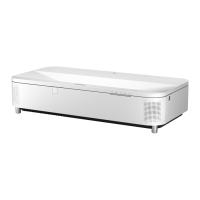See these sections to connect the projector to a variety of projection sources.
Attention
•
Che
ck the shape and orientation of the connectors on any cable you plan to
connect. Do not force a connector into a port if it does not t. e device or your
projector could be damaged or could malfunction.
•
Depending on the connected device and the shape of the cable, you may not be
able to attach the side cover to the projector. In that case, do not force the cover
into place. e device or your projector could be damaged or could malfunction.
See the Quick Start Guide for a list of cables supplied with your projector.
Purc
hase commercially available cables when necessary.
g
Related Links
•
"Co
nnecting to a Computer" p.33
•
"Connecting to Video Sources" p.34
•
"Connecting to External USB Devices" p.35
•
"Connecting to a Document Camera" p.36
•
"Connecting to an HDBaseT Transmitter " p.36
•
"Getting the Latest Version of the Documents" p.10
Connecting to a Computer
Follow the instructions in these sections to connect a computer to the projector.
g
Related Links
•
"Co
nnecting to a Computer for USB Video and Audio" p.33
•
"Connecting to a Computer for HDMI Video and Audio" p.34
Connecting to a Computer for USB Video and Audio
If yo
ur computer meets the system requirements, you can send video and audio
output to the projector through the computer's USB port. is function is called
USB Display. Connect the projector to your computer using a USB cable.
•
If yo
u use a USB hub, the connection may not operate correctly.
Connect the USB cable directly to the projector.
a
Connect the cable to your projector's USB-B port.
b
Connect the other end to any available USB port on your computer.
c
Turn on the projector and your computer.
d
Do one of the following to install the Epson USB Display s
owar
e:
You only need to install this sowar
e the rst time you connect the
projector to the computer.
•
Windo
ws: Select Run EMP_UDSE.EXE in the dialog box that is
displayed to install the Epson USB Display soware.
Projector Connections
33

